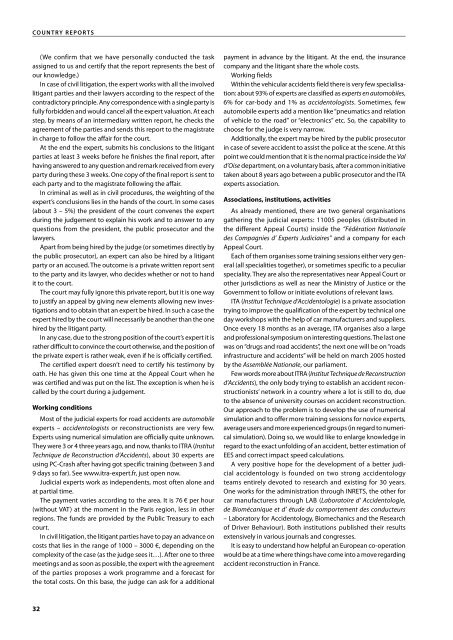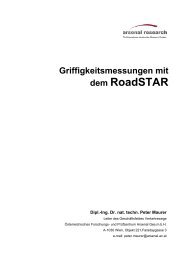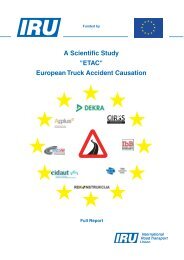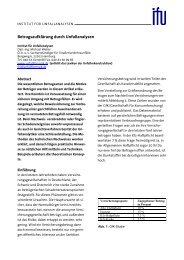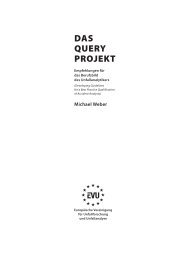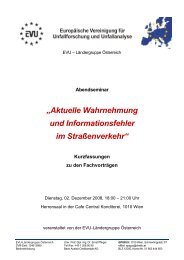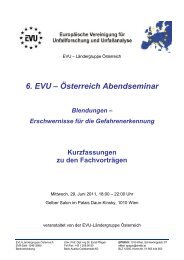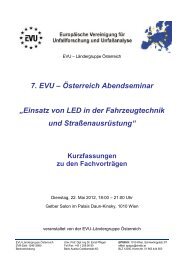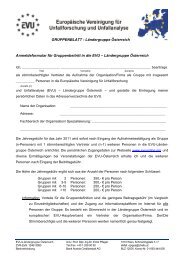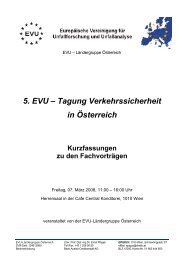THE QUERY PROJECT - European Commission - Europa
THE QUERY PROJECT - European Commission - Europa
THE QUERY PROJECT - European Commission - Europa
Create successful ePaper yourself
Turn your PDF publications into a flip-book with our unique Google optimized e-Paper software.
Co u n t R y R E P o R t S<br />
(We confirm that we have personally conducted the task<br />
assigned to us and certify that the report represents the best of<br />
our knowledge.)<br />
In case of civil litigation, the expert works with all the involved<br />
litigant parties and their lawyers according to the respect of the<br />
contradictory principle. Any correspondence with a single party is<br />
fully forbidden and would cancel all the expert valuation. At each<br />
step, by means of an intermediary written report, he checks the<br />
agreement of the parties and sends this report to the magistrate<br />
in charge to follow the affair for the court.<br />
At the end the expert, submits his conclusions to the litigant<br />
parties at least 3 weeks before he finishes the final report, after<br />
having answered to any question and remark received from every<br />
party during these 3 weeks. One copy of the final report is sent to<br />
each party and to the magistrate following the affair.<br />
In criminal as well as in civil procedures, the weighting of the<br />
expert’s conclusions lies in the hands of the court. In some cases<br />
(about 3 – 5%) the president of the court convenes the expert<br />
during the judgement to explain his work and to answer to any<br />
questions from the president, the public prosecutor and the<br />
lawyers.<br />
Apart from being hired by the judge (or sometimes directly by<br />
the public prosecutor), an expert can also be hired by a litigant<br />
party or an accused. The outcome is a private written report sent<br />
to the party and its lawyer, who decides whether or not to hand<br />
it to the court.<br />
The court may fully ignore this private report, but it is one way<br />
to justify an appeal by giving new elements allowing new investigations<br />
and to obtain that an expert be hired. In such a case the<br />
expert hired by the court will necessarily be another than the one<br />
hired by the litigant party.<br />
In any case, due to the strong position of the court’s expert it is<br />
rather difficult to convince the court otherwise, and the position of<br />
the private expert is rather weak, even if he is officially certified.<br />
The certified expert doesn’t need to certify his testimony by<br />
oath. He has given this one time at the Appeal Court when he<br />
was certified and was put on the list. The exception is when he is<br />
called by the court during a judgement.<br />
working conditions<br />
Most of the judicial experts for road accidents are automobile<br />
experts – accidentologists or reconstructionists are very few.<br />
Experts using numerical simulation are officially quite unknown.<br />
They were 3 or 4 three years ago, and now, thanks to ITRA (Institut<br />
Technique de Reconstruction d’Accidents), about 30 experts are<br />
using PC-Crash after having got specific training (between 3 and<br />
9 days so far). See www.itra-expert.fr, just open now.<br />
Judicial experts work as independents, most often alone and<br />
at partial time.<br />
The payment varies according to the area. It is 76 € per hour<br />
(without VAT) at the moment in the Paris region, less in other<br />
regions. The funds are provided by the Public Treasury to each<br />
court.<br />
In civil litigation, the litigant parties have to pay an advance on<br />
costs that lies in the range of 1000 – 3000 €, depending on the<br />
complexity of the case (as the judge sees it…). After one to three<br />
meetings and as soon as possible, the expert with the agreement<br />
of the parties proposes a work programme and a forecast for<br />
the total costs. On this base, the judge can ask for a additional<br />
payment in advance by the litigant. At the end, the insurance<br />
company and the litigant share the whole costs.<br />
Working fields<br />
Within the vehicular accidents field there is very few specialisation:<br />
about 93% of experts are classified as experts en automobiles,<br />
6% for car-body and 1% as accidentologists. Sometimes, few<br />
automobile experts add a mention like “pneumatics and relation<br />
of vehicle to the road” or “electronics” etc. So, the capability to<br />
choose for the judge is very narrow.<br />
Additionally, the expert may be hired by the public prosecutor<br />
in case of severe accident to assist the police at the scene. At this<br />
point we could mention that it is the normal practice inside the Val<br />
d’Oise department, on a voluntary basis, after a common initiative<br />
taken about 8 years ago between a public prosecutor and the ITA<br />
experts association.<br />
Associations, institutions, activities<br />
As already mentioned, there are two general organisations<br />
gathering the judicial experts: 11005 peoples (distributed in<br />
the different Appeal Courts) inside the “Fédération Nationale<br />
des Compagnies d’ Experts Judiciaires” and a company for each<br />
Appeal Court.<br />
Each of them organises some training sessions either very general<br />
(all specialities together), or sometimes specific to a peculiar<br />
speciality. They are also the representatives near Appeal Court or<br />
other jurisdictions as well as near the Ministry of Justice or the<br />
Government to follow or initiate evolutions of relevant laws.<br />
ITA (Institut Technique d’Accidentologie) is a private association<br />
trying to improve the qualification of the expert by technical one<br />
day workshops with the help of car manufacturers and suppliers.<br />
Once every 18 months as an average, ITA organises also a large<br />
and professional symposium on interesting questions. The last one<br />
was on “drugs and road accidents”, the next one will be on “roads<br />
infrastructure and accidents” will be held on march 2005 hosted<br />
by the Assemblée Nationale, our parliament.<br />
Few words more about ITRA (Institut Technique de Reconstruction<br />
d’Accidents), the only body trying to establish an accident reconstructionists’<br />
network in a country where a lot is still to do, due<br />
to the absence of university courses on accident reconstruction.<br />
Our approach to the problem is to develop the use of numerical<br />
simulation and to offer more training sessions for novice experts,<br />
average users and more experienced groups (in regard to numerical<br />
simulation). Doing so, we would like to enlarge knowledge in<br />
regard to the exact unfolding of an accident, better estimation of<br />
EES and correct impact speed calculations.<br />
A very positive hope for the development of a better judicial<br />
accidentology is founded on two strong accidentology<br />
teams entirely devoted to research and existing for 30 years.<br />
One works for the administration through INRETS, the other for<br />
car manufacturers through LAB (Laboratoire d’ Accidentologie,<br />
de Biomécanique et d’ étude du comportement des conducteurs<br />
– Laboratory for Accidentology, Biomechanics and the Research<br />
of Driver Behaviour). Both institutions published their results<br />
extensively in various journals and congresses.<br />
It is easy to understand how helpful an <strong>European</strong> co-operation<br />
would be at a time where things have come into a move regarding<br />
accident reconstruction in France.


